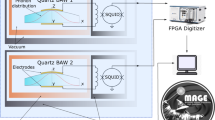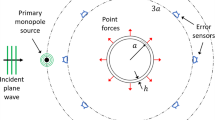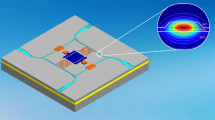Abstract
Non-elastic audiofrequency vibrational modes in aluminium and other metals are suggested as a possible reason for the differences reported by various observers using large aluminium alloy bars (or disks) as gravity-wave detectors. Loading of suspended gravity-wave detector bars resulting from the gravitational attraction of the Earth is also sufficient to produce the small stresses required for the self-generation of audiofrequency sounds (acoustic emission) in materials. Both the non-elastic mode response and acoustic emission frequencies depend critically on the exact microstructure and/or residual stress state of a bar.
This is a preview of subscription content, access via your institution
Access options
Subscribe to this journal
Receive 51 print issues and online access
$199.00 per year
only $3.90 per issue
Buy this article
- Purchase on Springer Link
- Instant access to full article PDF
Prices may be subject to local taxes which are calculated during checkout
Similar content being viewed by others
References
Weber, J., Phys. Rev. Lett., 22, 1320–1324 (1969); ibid., 24, 276–279 (1970); ibid., 25, 180–184 (1970).
Weber, J., Lee, M., Gretz, D., Rydbeck, G., Trimble, V., and Steppel, S., Phys. Rev. Lett., 31, 779–783 (1973).
Logan, J. L., Physics Today, 6, no. 3, 44–52 (1973).
Levine, J. L., and Garwin, R. L., Phys. Rev. Lett., 31, 173–176 (1973).
Tyson, J. A., Phys. Rev. Lett., 31, 326–329 (1973).
Lubkin, G. B., Physics Today, 26, no. 10, 17–19 (1973).
Baron Rayleigh, The Theory of Sound, 1, 246–247 (Dover, New York, 1945).
Handbook of Chemistry and Physics, 39th ed. (Chemical Rubber Publishing Co., Cleveland, Ohio, 1957).
Weber, J., Nuovo Cim., 4 B, 197–204 (1971).
Fitzgerald, E. R., J. acoust. Soc. Am., 39, 856–869 (1966).
Fitzgerald, E. R., Particle Waves and Deformation in Crystalline Solids (Wiley, New York, 1966).
Hirsch, P. B., Prog. Metal Phys., 6, 263–339 (1956).
Heidenreich, R. D., J. appl. Phys., 20, 993–1010 (1949).
Beck, P. A., and Hu, H., Trans. AIME, 185, 627–634 (1949).
Kellar, J. N., Hirsch, P. B., and Thorpe, J. S., Nature, 165, 554–570 (1950).
Fitzgerald, E. R., Phys. Rev., 108, 690–706 (1957).
Portevin, A., and Le Chatelier, F., C. r. hebd Séanc. Acad. Sci., Paris, 176, 507–510 (1923).
Klassen-Nekludova, M., Z. Phys., 55, 555–568 (1929).
Kaiser, J., Arch. Eisenhuettenv., 50, 43–45 (1953); Forsch. Ing. Wes., 23 (1951).
Schofield, B. H., Bariess, R. A., and Kyrala, A. A., Acoustic Emission under Applied Stress (ASTIA Document No. AD155674, 1958).
Schofield, B. H., Aeronautical Research Laboratory Tech. Rep., ARL-150 (1961).
Schofield, B. H., Tech. Documentary Rep. Nos ASD-TDR-63-509 (1963) and ASD-TDR-63-509 (1964).
Author information
Authors and Affiliations
Rights and permissions
About this article
Cite this article
Fitzgerald, E. Audiofrequency vibrations and gravity-wave detectors. Nature 252, 638–640 (1974). https://doi.org/10.1038/252638a0
Received:
Issue Date:
DOI: https://doi.org/10.1038/252638a0
Comments
By submitting a comment you agree to abide by our Terms and Community Guidelines. If you find something abusive or that does not comply with our terms or guidelines please flag it as inappropriate.



